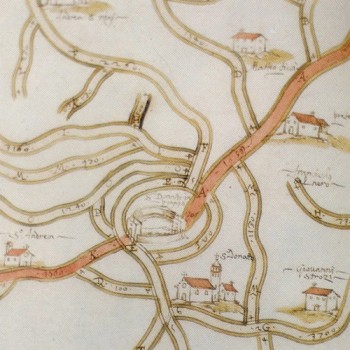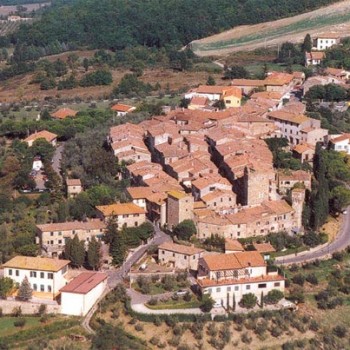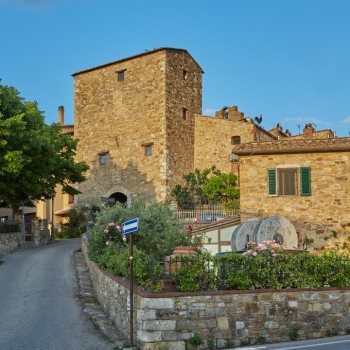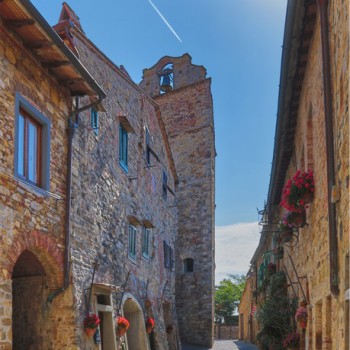History of San Donato in Poggio
San Donato in Poggio is an ancient medieval town lying on the summit of a hill (“Poggio”) to whom it gives its name, that separates the valley of the river Pesa from the river Elsa.
Since 11 March 2023 it has been included in the network “The most beautiful villages in Italy”
The most ancient written testimonies talking about San Donato are three parchments of the State files dated 985, 986, 988 and a parchment dated 989 of the Passignano Abbey. In the Medieval Epoch it was named San Donato in “Loco Pocie”, “Poce”, or in “Podio” and subsequently San Donato in Poggio. In 1033 it became a fortified castle “Castrum”. In 1091 Henry VI granted half of San Donato in Poggio, in feud, to the Counts Guidi. The town soon gained a strategic importance, as it was on the Roman path that connected Florence to Siena in the XIV century.
In the late medieval epoch, after historical conflicts between Guelfi and Ghibellini, San Donato is remembered for being twice the place chosen for treaties of peace, between the two rival Republics of Florence and Siena. In 1260 the Florentine army assembled in the castle of San Donato before the battle of Montaperti against the Republic of Siena. In 1289 it was partially destroyed by the Ghibellini Aretini during the war with Florence, but after the raid, the Florentine Republic and the parish priest of San Donato Bernardo Gherardini (descendent of a family that had a lot of properties, villas and castles in Val di Pesa) financed immediately the reconstruction and the amplification of the fortified walls. In 1313 the fortified suburb, provided with a fortress, was over taken by the militias of Arrigo VII. Because of administrative rearrangements of the city of Florence and its surroundings, San Donato in Poggio was set at the head of a League, guided by a Podestà sent from the Florentine Republic.
Today, only part of the fortified walls remains, the two doors that give access to the village (Porta Fiorentina and Porta Senese), the bell tower (The Campanone), the tower post to guard the valley (Torrino) and numerous buildings that have preserved the medieval and original structure of their towers, portals and arcs in alberese stone. The medieval urbanistic structure of the roads and the central square still preserve the same original characteristics. Malaspina square is very suggestive, with its octagonal well surrounded by the building of Ticci, that became Malaspina, by the church of Santa Maria della Neve, from the XIV century and by the Palazzo Pretorio, destroyed in the last war (as numerous other buildings as Porta Senese) where inside there is still a fresco of the second half of the XIV century, representing the Virgin Mary with her Child among the Saints
Outside the fortified walls there was a hospital for the poor managed by the Agostiniani monks that later on was past to the confraternity of Santa Maria delle Neve.
The church of San Donato (Pieve), was built outside the walls around the year 1000 outside the castle, this is one of the most typical examples of the Florentine Romanesque architecture in the Chianti Area. The church has three aisles that end with three semi-circular apses, that englobes the preexisting bell tower, the façades were built in squared filaretto of alberese stone, and inside it conserves still the baptismal source in glazed terracotta, from Giovanni Della Robbia (1469-1529), a crucifix attributed to Taddeo Gaddi (1300 – 1366) disciple of Giotto for 24 years. Other works that once were exposed on the walls of the baptistery are now preserved, for safety reasons, in the Museum of the Church of S. Stefano on the Ponte Vecchio in Florence. In Pietracupa, close to the castle, lies the Sanctuary of Santa Maria delle Grazie, building of the 1600, containing important pictorial works of Domenico Cresti called “The Passignano” and of Gamberucci. The beautiful image of Virgin Mary with the Child is a fresco of the year 400, for a long time attributed to Masaccio, and recently attributed to Paolo Schiavo (1397-1478).





















